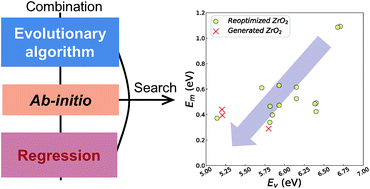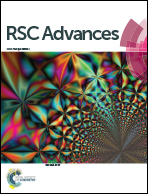Discovery of zirconium dioxides for the design of better oxygen-ion conductors using efficient algorithms beyond data mining†
Abstract
It is important to find crystal structures with low formation (Ev) and migration-barrier (Em) energies for oxygen vacancies for the development of fast oxygen-ion conductors. To identify crystal structures with lower Ev and Em than those of ground-state ZrO2, we first reoptimize the crystal structures of various oxides reported in the database, and then directly construct them using an evolutionary algorithm. For efficient searching, we employ the linearized ridge regression model for Ev using descriptors obtained from density functional theory calculations of the unit cells and apply the predicted Ev as a fitness value in the evolutionary algorithm. We also find a correlation between the Ev and Em for the crystal structures of ZrO2. On the basis of this correlation, we confirm that the newly constructed crystal structures, as well as certain reoptimized structures from the database, that possess low Ev also have Em lower than that of ground-state ZrO2. Our successful strategy consisting of a combination of the evolutionary algorithm, first-principles calculations, and machine-learning techniques may be applicable to other oxide systems in finding crystal structures with low Ev and Em.



 Please wait while we load your content...
Please wait while we load your content...